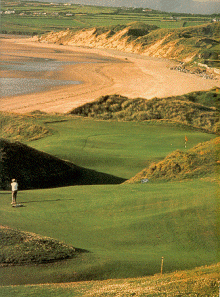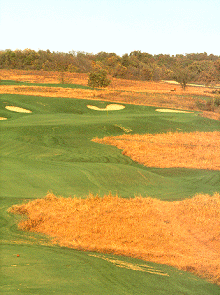|
The Library
How to Lower Your Score by Reading the Features of a Course Chapter 1: The Playing Field Golf Course Settings In my view, there are six geographical categories of courses: links or seaside, prairie, parkland, desert, mountain, and tropical. Your first lesson in course mastery is to be aware of the significant natural factors that should influence how you approach a course. Obviously, areas have common characteristics, but it is the specific combination of factors that gives each geographic category as distinctive identity. Links or Seaside Courses
Classic courses such as St. Andrews tend to hold a grip on the imaginations and attitudes of those who play them. Because of history and tradition, there is a sense of reverence for the game played here. You feel as if you’re walking on sacred and mystic ground. To wit, at the Old Course, fourteen holes (Nos. 2 and 16 through Nos. 8 and 10) are served by double greens. Curiously, when the hole numbers of each set of double greens are combined they add up to 18, the traditional number of holes on a course. I have no idea what it means, but who I am to question the superstitions of the Scots. St. Andrews is built on “linksland” - the sandy, undulating hills or dunes formed along a coastline by wind and waves. Other celebrated links courses, like Royal Dornoch in Scotland, are located on rolling sandy terrain adjacent to estuaries. Links courses are notable for a number of reasons. To golfers raised on parkland or mountain courses, links courses lack apparent definition. The tremendous openness of the seaside setting does not provide natural markers, such as trees and hills, that golfers usually rely on to judge distance. The effect is a certain disorientation that made a friend lament, “You play a links course by Braille - with fourteen clubs, a white cane, and a trusty seeing-eye dog.” Don’t look for symmetry at Ballybunion Golf Club in Ireland or the Turnberry Golf Courses in Scotland. The early players and designers were inclined to follow natural paths in the earth, rather than superimpose a routing plan, and that was the game pure and simple. To give themselves a better chance, they played between the dunes and out of the wind. Links courses have an irregular quality about them. As you walk them your feet begin to feel the many bumps and rolls, and the hidden swales reveal more contour than expected. The ground traditionally is firm, sharp bounces are common, and tiny pot bunkers excruciating. Lately, however, as five-time British Open champion Tom Watson has pointed out, the installation and extensive use of modern irrigation systems have made many links courses much lusher, thereby softening them and, in the process, compromising some of their unique playing characteristics. Generally, links courses feature indigenous fescue grass, which tends to produce tight (thin) lies. Fescue rough tends to be swirly and light, and playing out of it generally is fairly easy due to its light clubhead resistance. However, the other forms of rough encountered on a links course are an entirely different story. Rely on a caddie or local member to help you decide if you can extract your ball from infamous gorse and heather. When in doubt, use a lofted club and play to the fairway. It will save you strokes and ligaments. A friend played Royal County Down in Northern Ireland. On the 440-yard par-4 fifth hole, he pushed his drive into tall fescue grass and gorse on the right, and the foursome spent considerable time looking for the ball. Finally, his caddie found it but then couldn’t find the bag, having laid it down in the high rough during the search. An inauspicious start to say the least. Links courses rely heavily on wind to provide part of the challenge. Some would argue that seaside courses without wind are relatively tame. When Faldo won the British Open at St. Andrews in 1990, incredibly, the wind did not blow during any rounds, resulting in unusually low scoring. Conversely, when a gale wind kicks up - the norm - woe to the golfer who can’t keep the ball low or hit punch shots. You have not played a links course unless you’ve jousted with the wind. Spaniard Seve Ballesteros can attest that the wind frequently emerges as the victor. At Muirfield in the 1987 British Open, Seve needed three full shots and a short iron to reach the green on the 558-yard par-5 fifth. Ballesteros is a man who reaches most par-5s in two, often with a driver and a long iron. Success on seaside courses often depends on your ability to gauge winds. I usually ask a local golfer about wind currents so I can “align” shots more effectively. Good players actually try to bank shots off crosswinds, like a pilot angling a plane during a crosswind landing. The effective distance into the wind on a given hole often leaves newcomers incredulous. For example, a 9-iron shot on a windless day may call for a 3-iron in a gale. Caddies often say, “The yardage is a bit longer today, sir. We have a two-club wind.” That means you need to add two clubs to carry the distance. From a shot-making standpoint, the low, along-the-ground, bump-and-run and knockdown shots are necessary weapons on a properly maintained links course. Under true links conditions, being able to keep the ball low and run it to the hole will definitely help your score. During the process of winning the 1972 British Open at Muirfield, Lee Trevino, a native Texan, used a Texas wedge (a putter) around the greens to combat the firm ground and wind. Prairie Courses Prairie courses are cousins to inland heath courses, which were offshoots of the original linksland courses. Until the second half of the nineteenth century, links seemed to be the only terrain that could support a proper golf hole. Attempts to build on clay soils failed because greens were rock hard in summer and mushy in winter. Finally, someone recognized that heathland, which shares important drainage similarities with links, was almost ideal for laying out a course.
When I play prairie courses, I always keep in mind that they are similar to links courses in a number of respects. For example, they are susceptible to winds, often fierce, from different directions. If the situation dictates, you should favor low, running shots - assuming the design affords an open entry to the green. It’s basically decisiveness and feel. Great Plains courses in Big Sky country, where looming horizon influences perception. Accordingly, you should determine distances incrementally by breaking a hole into small parts and locating intermediate markers you can judge with accuracy. An edge of a bunker, a rise in a mound, or another notable landmark can help you determine the length of your shot. Or, ask a caddie or a local player for yardages. Prairie courses are in regions subject to radical and surprising weather changes, ranging from sudden, sharp winds, cold spells, severe thunderstorms, and tornadoes, to searing heat, which debilitates even the strongest players. Temperatures can change dramatically in the span of a few minutes, affecting everything from the distance the ball carries to the amount of clothing you may need. Such courses require the ability to adjust to the elements - often several times during the round - to perform at your best.

|

